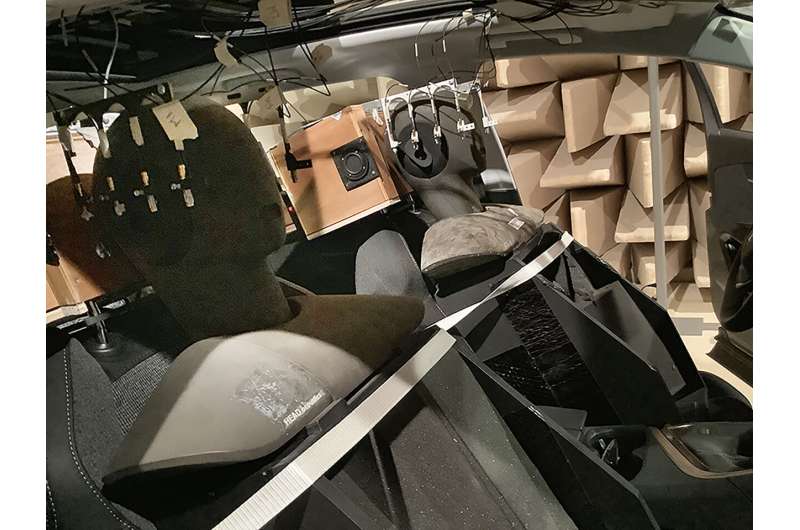Measured system in a car cabin. Credit: Lucas Vindrola
Creating an individualized listening experience for each passenger has been an ambition for the auto industry for decades. The acoustically changing nature of the car cabin has hampered making such personalized sound zones (PSZs) a reality.
In The Journal of the Acoustical Society of America, researchers from Stellantis and Laboratoire d'Acoustique de l'Universite du Mans outline an algorithm that adapts PSZs within a car to changes in seat position, allowing riders to listen to their own audio without headphones and interruption. The algorithm coordinates different sound sources in the car's cabin to produce "bright" zones with good sound quality and "dark" zones of reduced quality.
"This technology should eventually allow each passenger to listen to his or her own audio program without disturbing others and without using headphones," said author Lucas Vindrola.
PSZs are often achieved through an array of speakers and filters that manipulate the filters to tune the acoustic paths, called transfer functions, to desired zones of the car. While it is possible to create these arrays and calibrate them before cars are sold, these transfer functions are prone to changes within the car, including changes in car temperature, number of passengers, or seat positions.
To overcome this, the group placed microphones in the car to monitor sound characteristics from the different sources in real time. The algorithm adapts the existing filters whenever there is a modification of the acoustic environment, for example, in the seat positioning.
"Loudspeakers are placed in the headrests, and specific filters for each transducer are calculated to reproduce an audio signal that retains good quality in the zone under consideration and is strongly attenuated in other zone," Vindrola said.
The system maintains a 30-decibel difference in loudness between the two front seats, roughly the difference between conversing with someone and whispering. It can reliably achieve this sound discrimination even if a seat moves up to 5 inches.
"The price to pay is to have control microphones in the passenger compartment, so that the algorithm can work," Vindrola said. "The results remained interesting even when the number of control microphones was reduced."
He said the system has strong potential for other uses, such as home audio systems and museums.
The algorithm only accommodates sounds from 100 to 1,000 hertz, a range that corresponds from bass notes to intelligible human speech. Next, they look to increase the bandwidth to 10,000 hertz, which could convey sounds like the highest note on a piano and most of the more intricate sounds in speech.
The article, "Use of the filtered-x algorithm to adapt personal sound zones in a car cabin," is authored by Lucas Vindrola, Manuel Melon, Jean-Christophe Chamard, and Bruno Gazengel. The article will appear in The Journal of the Acoustical Society of America on Sept. 14, 2021.
More information: "Use of the filtered-x algorithm to adapt personal sound zones in a car cabin," Journal of the Acoustical Society of America (2021). aip.scitation.org/doi/full/10.1121/10.0005875
Journal information: Journal of the Acoustical Society of America
Provided by American Institute of Physics
























